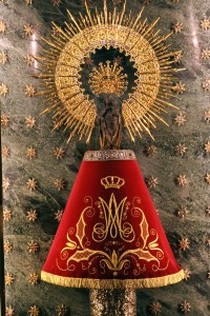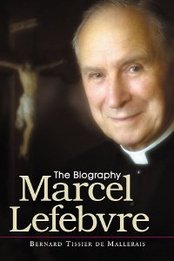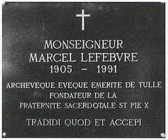
Tradition dates the origin of the Our Lady of Pillar shrine to the year 40 A.D., when St. James the Apostle was sitting here on the bank of the Ebro River, discouraged and heartsick at his lack of success in bringing Christianity to the region. The Virgin Mary appeared to him and reassured him that his efforts would not be in vain. She also asked him to consecrate a church in her name, and left behind a pillar of jasper to mark the spot where she had made her appearance.
As Mary promised, St. James was indeed successful in bringing Christianity to Spain, and the place of his encounter with the Virgin became a holy place. Through the centuries—including years when Zaragoza was under Muslim control, when it suffered from plague and famine, and through years of civil war and unrest—this site has continued to draw the faithful. Holy men and women such as St. John of the Cross, St. Teresa of Avila, and St. Ignatius of Loyola have all made the journey here to show their devotion to Our Lady of Pilar, who is the patroness of Spain.
The most prominent miracle associated with the shrine happened in the seventeenth century to a poor beggar named Miguel Juan Pellicer from the town of Calanda. Unable to work because of an amputated leg, he had a great devotion to the shrine and frequently prayed there for help. The Virgin Mary answered his prayers by restoring his missing leg, and after word spread of the miracle, the number of pilgrims to the church greatly increased.
Multiple church structures have occupied the site, each one larger than the one it replaced. Today the Basilica de Nuestra Senora del Pilar, as it is formally known, includes 11 brightly colored tiled domes and is the second biggest church in Spain (only the cathedral in Seville is larger). Its construction was begun in 1681 under the direction of King Charles II. Parts of its interior date back even farther, including a magnificent main altar of alabaster designed by Damian Forment in the fifteenth century. Two of the frescos that line its domes were painted by Goya, the famous eighteenth-century Spanish artist who was born in the nearby village of Fuendetodos.
Our Lady of Pilar came to international prominence when in 1492 Christopher Columbus landed in the New World on her feast day of October 12. She was subsequently named patroness of the New World. In the early twentieth century, the shrine also played an important role in the founding of the Opus Dei movement. As a young seminarian in Zaragoza, St. Josemaria Escriva, the founder of Opus Dei, made daily visits to Our Lady of Pilar to pray for guidance. Opus Dei members continue to honor her feast day each year.
The Pilar Church (also known as the Basilica de Nuestra Senora del Pilar) in Zaragoza is the center of pilgrimages to Our Lady of Pilar. Inside, a Roman-style pillar is topped by a statue of the Virgin Mary and baby Jesus that dates from the fifteenth century. It is housed in a chapel of marble, jasper, and gilded bronze that forms almost a church-within-a-church (see here for more on the history of the shrine).
The pillar itself is typically covered with an elaborate vestment called a manta. The vestments have been donated by countries, states, cities, and individuals from around the world, including every Latin American nation. Some 20 new mantles are donated each year.
Visitors to the church may notice a curious memorial that hangs to the side of the chapel. Two bombs are displayed there, a symbol not of violence, but of miraculous intervention. During the opening days of the Spanish Civil War in 1936, the two bombs were dropped on the church by airplanes. Miraculously, neither exploded. They remain today as a reminder of how the power of love is stronger than any armament.
The Pilar Church is the dynamic center of life in Zaragoza. Each day hundreds of visitors pass through its doors to attend mass or pray privately in the shrine’s chapel. Most also go to the back of the chapel, where people can kneel and kiss the pillar itself. Another popular custom happens each evening when young children are presented to the Virgin. Altar boys take the children and carry them to the front of the pillar, where their picture is taken by families standing outside the altar rail.
Outside the basilica lies the largest pedestrian plaza in Spain, a picturesque expanse lined with cafes and fountains and the site of frequent musical performances, festivals, and other public events. The Plaza del Pilar is at its most colorful in mid-October, when it becomes the focal point of a nine-day festival in honor of Our Lady of Pilar. More than 400,000 people flock to Zaragoza for the celebration, which includes folk dancing, theater performances, concerts, and procession with Gigantes y Cabezudos (giants and bigheads), huge papier mache characters that bob and weave through the crowds.
At the other end of the plaza stands the cathedral of La Seo. Built originally as a mosque, it blends Gothic and Baroque elements with a uniquely Spanish architectural form called Mudejar. Characterized by rich ornamentation in brick, plaster, and ceramics, Mudejar buildings were created by Muslim artisans working under Christian rule. Zaragoza has some of the finest Mudejar structures in the country, including La Seo and the Magdalena Church, another Zaragoza landmark. Pilgrims may also want to visit Santa Engracia Basilica, which holds the bones of martyrs killed by the Romans in 303 A.D.
Our Lady of Pilar Ribbons
One of the most charming customs associated with Our Lady of Pilar involves brightly colored ribbons. In years past, people would ask to have a manta of the Virgin (one of the vestments that cover the pillar) brought to them when they were sick or dying. The requests became too numerous to accommodate, and so the church began to offer ribbons that are about 15 inches in length, the height of the statue on top of the pillar.
Offered in a rainbow of colors, each ribbon is stamped with these words in Spanish: “The measurement of Our Lady of the Pillar.” While there is no charge for the ribbons, a donation of one Euro (about $1.40) is requested.
The brightly colored ribbons that pilgrims receive at the shrine can be seen throughout the Aragon region, adorning taxi cabs, bicycles, and other vehicles as a sign of protection and blessing




